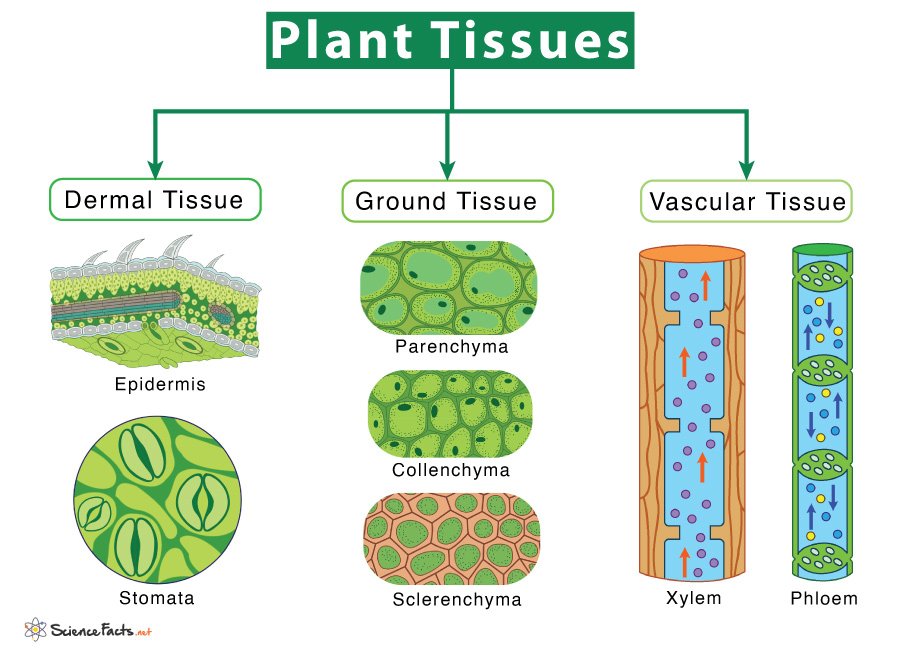Plant Tissues
Plant tissues are of two main types: meristematic tissue and permanent tissue. Meristematic tissue is like stem cells in animals that have the potential to divide throughout life, thus contributing to plant growth. They are found in the stem and root meristems.
Types of Meristematic Tissue
Meristematic tissues are of three types, based on their location in plants. They are:
1. Apical Meristems
They are found at the tips of roots and stems, enabling a plant to extend in length.
2. Lateral Meristems
They are found on the lateral side of the stem and root of a plant, facilitating growth in thickness or girth.
3. Intercalary Meristems
They occur only at the bases of leaf blades and nodes of monocots. These help the plant to increase in length from the leaf base.
Types of Permanent Tissue
When meristem cells differentiate and become specialized, they lose their availability to divide and form nonmeristematic or permanent tissue. Such cells assume specific roles and lose their ability to divide.
Meristematic tissues transform into three types of permanent tissues. Each type of tissue consists of different cell types, has different functions and is located in different places.
1. Dermal Tissue
Dermal tissue forms the outermost covering of the plant, called the epidermis. In stems and leaves, the dermal tissue is covered by a waxy cuticle that prevents water loss due to transpiration. In the leaf, some minute openings called stomata (singular: stoma) in the cuticle layer allow gas exchange. Each stoma is covered by a pair of bean-shaped guard cells that regulates its opening and closing.
Unlike stems and leaves, the dermal layer of root gives rise to some lateral outgrowths called root hairs. Trichomes, or small hairlike or spikey outgrowths of epidermal tissue, sometimes found on the stem and leaves, aid in defense against herbivores.
In woody plants, the epidermis breaks into a multi-layered periderm (or bark) as secondary growth allows plants to grow in girth. The periderm functions as the plant’s first line of defense, protecting it from injury, dehydration, fire, and pathogens.
2. Ground Tissue
Ground tissue comprises much of the interior of a plant and helps in metabolism, storage, and support. Depending on location and function, ground tissues are made of three cell types:
a. Parenchyma
They are spherical, elongated cells with a thin and flexible primary cell wall but lack a secondary cell wall. Parenchyma cells are totipotent and thus have the ability to divide and differentiate into any cell. They are the main component of young plant organs. They are found in almost all cell types, such as in mesophyll cells, stem cortex, and pith, and as a component of vascular tissues
b. Collenchyma
Like parenchyma cells, collenchyma also lacks secondary cell walls but is thicker than primary cell walls. As their cells are long and thin, they can stretch and elongate, which helps them provide structural support in growing regions of the stem and leaves.
c. Sclerenchyma
Unlike other ground tissues, sclerenchyma has secondary cell walls composed of lignin. This tough substance is the primary component of wood. So, these cells cannot stretch and are dead. They provide structural support to the plant.
3. Vascular Tissue
It includes two types of conducting tissues: xylem and phloem. Xylem conducts water and minerals from the roots to different plant parts and plays a role in structural support in the stem. On the other hand, phloem transports organic compounds from the site of photosynthesis to other parts of the plant. The xylem and phloem form the vascular bundle in roots, stems, and roots.
FAQs
Ans. No, plants and animals are made up of different kinds of tissues.
Ans. The flesh of potatoes is made of parenchymal cells.
Ans. Vascular tissue.
Ans. Dermal tissue makes up the outside of a plant which helps in the interactions between a plant and its environment. In contrast, ground tissue makes up most of a plant’s interior, carrying out essential metabolic functions and storing food and water.
Ans. Dermal tissue surrounds the outside of a plant and thus controls its interactions with the surrounding environment. Ground tissue is found in the plant’s interior and functions in storage, photosynthesis, support, regeneration, and protection. In contrast, vascular tissue in vascular bundles is involved in transporting water and minerals throughout the plant.
-
References
Article was last reviewed on Thursday, May 9, 2024




